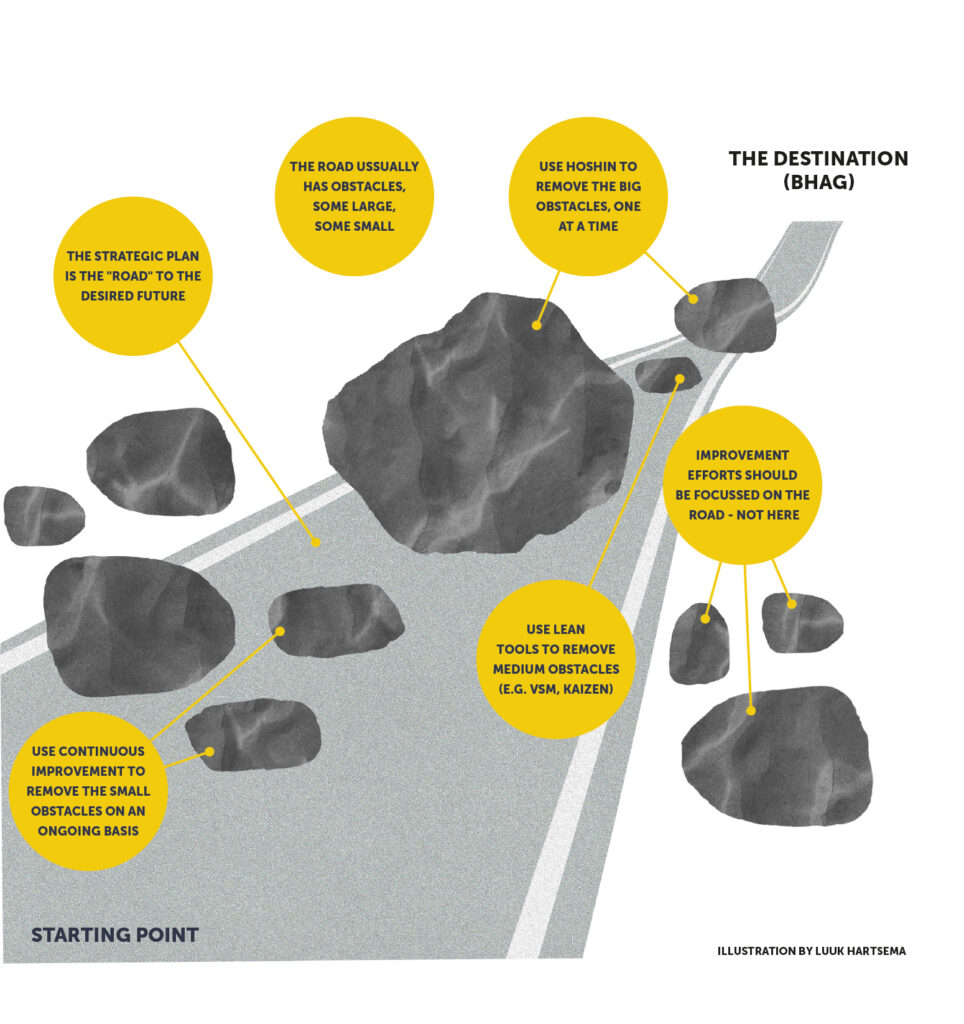Applying Lean principles in a Holacratic organization: the Policy-X Matrix
Written by Luuk Hartsema on 19th November 2020
This article is second in a series of three where colleagues Luuk, Bart, and Ronald talk about applying Lean principles in our Holacratic organization. The first story can be read here.
During the early stages of the 100-day approach, Bouke had to learn fast. We embraced him as one of our own colleagues. We gave him a Devhouse Spindle hoodie and within no time he was one of the Spindlers. It enabled him to truly understand our Holacratic way of work, observe our processes, get to know the colleagues, comprehend our culture and values, and identify improvement potential.
Going Gemba
In comparison to having an outsider consult on how to improve, Bouke became fully immersed within our organization and that made a significant contribution to the amount of transparency and trust he received. He joined us in our daily operations.
Lean thinking promotes “Going Gemba”. Gemba is a Japanese term that means “on-site”. Japanese detectives call a crime scene also a Gemba. In a work environment, the purpose of Go-Gemba is to visit the place where it all happens and understand what is happening and why it is happening.
The whole is more than the sum of its parts
It’s easy to approach Holacracy in a very pragmatic way. The explicitness of a Holacratic role description can lead to pigeonholing. One might think: “this is my explicitly defined area where I can exercise strength in my expertise. Everything else does not belong to my role or accountabilities, so does not concern me”.
Although this might be true to a certain extent, Holacracy would not be called Holacracy if it didn’t intend to encourage holistic thinking. The whole is more than the sum of its parts. The term “holistic thinking” refers to a big picture mentality in which a person recognizes the interdependencies between their own work and the work of others.
In other words, look beyond your own expertise and make sure you truly understand:
- How does my expertise relate to others?
- How is my expertise relevant to the organization?
- How does my work fit in the bigger picture?
- How do the decisions I make impact others (either now or in the future)?
- Which other expertises can or should be involved to resolve the challenges we have?
- What are we aiming to accomplish as a company?
On feedback and finding common grounds
Holacracy encourages colleagues to take ownership of their roles. Distributed ownership, in combination with very kind and friendly colleagues, fostered a situation in which we experience difficulty giving feedback on roles (and accountabilities) that we do not own. Holacracy honours the sovereignty of each role.
Suggesting that improvement is needed can feel like criticising colleagues. At the same time roles are sovereign to determine their own priorities, and may not see the need to improve things that at first glance seem to have less of an impact on their own activities. Being able to see how improvements affect a chain of circles and roles – having a holistic view – can make a difference here.
We prefer to avoid situations in which the impression could be given that we are impairing the sovereignty of a role or are criticising colleagues. That avoidance can be so strong that people decide to find (sub-optimal) workarounds, instead of continuing initiatives that lead to lasting improvement and better collaboration between roles.
Introducing the Policy-X Matrix
While we were becoming more knowledgeable about the background and causality of some long lingering tensions, Bouke introduced the Policy-X Matrix, which is part of the Hoshin Kanri philosophy. The Japanese word Hoshin means “direction” or “compass needle”. Kanri means “control” or “management”. The Policy-X Matrix is a standard Lean method used by many organizations. The intention of the Hoshin Kanri philosophy is to let the strategic goals of the organization guide every decision and action.

Enhancing our existing outlook process
We have been practicing self management for more than seven years now. At first a clear “how” and “why” (our purpose) was enough to find alignment. When we had more than 30 colleagues, the need for a clear distributed process to determine our strategy became more prominent.
In the search for existing methodologies we found inspiration in the “Rockefeller Habits” theory by Verne Harnish. The “One page strategy plan” as described in his book “Scaling Up” seemed to have a good fit with our organization. Over the course of time we have built on that, made it our own, and simplified it to 19 questions. Teams (circles) can walk through those questions together in order to determine their strategy.
We have called this process the “outlook process”. Every team goes through the process several times a year, and every team has their own single page outlook paper in which output of the process is captured. You can read all about it here (written by our sister company Voys, in Dutch).
Together with Voys, we are now with over 120 colleagues in total. Working together with so many colleagues in a self-managing organization makes setting strategies and aligning them even more challenging.
The Policy-X Matrix is very strong in visualizing interdependencies and cohesion of:
- Projects / Key initiatives (4 months)
- Short-term goals (1 year)
- Long-term goals (3 years)
- Metrics
- Accountabilities
This specific quality of the matrix turned out to be a welcome addition to our outlook process.
Suddenly it became clear at a glance
As a result of being introduced to the Policy-X Matrix, a group of colleagues started to have more conversations about how their projects and goals should contribute to the goals of the organization as a whole.

Ideally, everything should roll up gradually towards our company goals. While we were filling in our first matrix, it became clear that this is not as apparent as we believed it was. Our first matrix surfaced multiple tensions about the output we had captured in our single page outlook papers.
Navigating through discussions has been difficult due to personal pet peeves and finding it hard to become tangible about what we want to accomplish. We all personally care a lot. Good preparation and a parking place for ideas and concerns gave us space to facilitate a dialogue (instead of a debate). People rightly started to question some of the goals due to a lack of clear and straightforward alignment with the company goals.
Tensions are good!
As stated in our previous article; tension is fuel for your organization. And thus the Policy-X Matrix proved itself valuable. The matrix helped us to see how we could improve our strategic output and strategize better. We have made an improvement to our single page outlook paper by integrating parts of the Policy-X Matrix. This is something we are currently experimenting with by expanding it further into the organization.
If you are interested to learn more about the Policy-X Matrix, we can recommend this simple but informative YouTube video.
We have started an improvement that will eventually lead to an increased sense among colleagues that their work is adding value and they are accomplishing impact towards our purpose. After all, we are a purpose-driven organization that wants to facilitate equality by providing access to unrestricted communication. Having a personal sense of contributing to that purpose makes us happy.
The next steps: Kaizen circle and Waste walks
Clarity about our goals helps to define areas (in line with the aforementioned goals) where we need to improve. In our next article we will elaborate further on the Lean methodologies, such as the Kaizen circle and Waste walks that assisted us in those improvements. These methodologies created a mindset in which we improved collaboration, reduced waste and increased our focus on measurable impact. Stay tuned!




Your thoughts
No comments so far